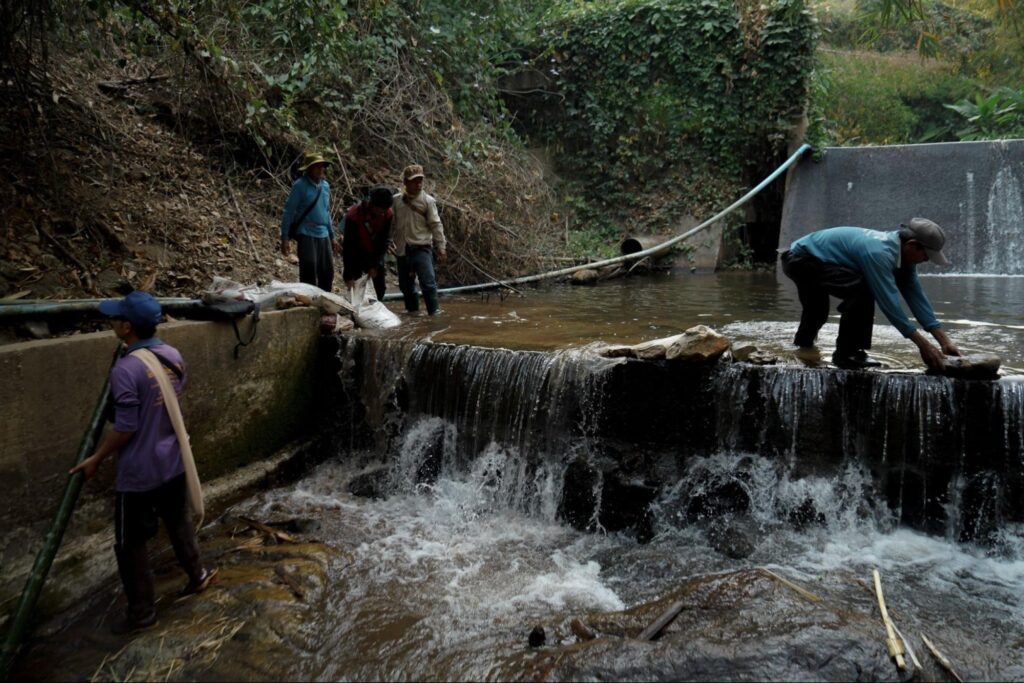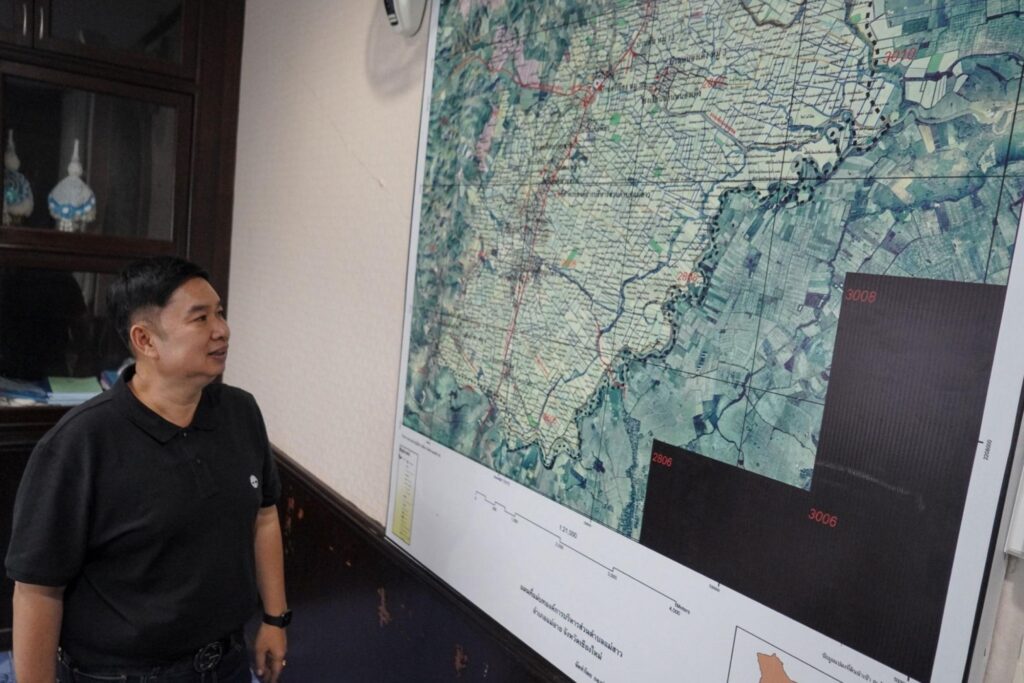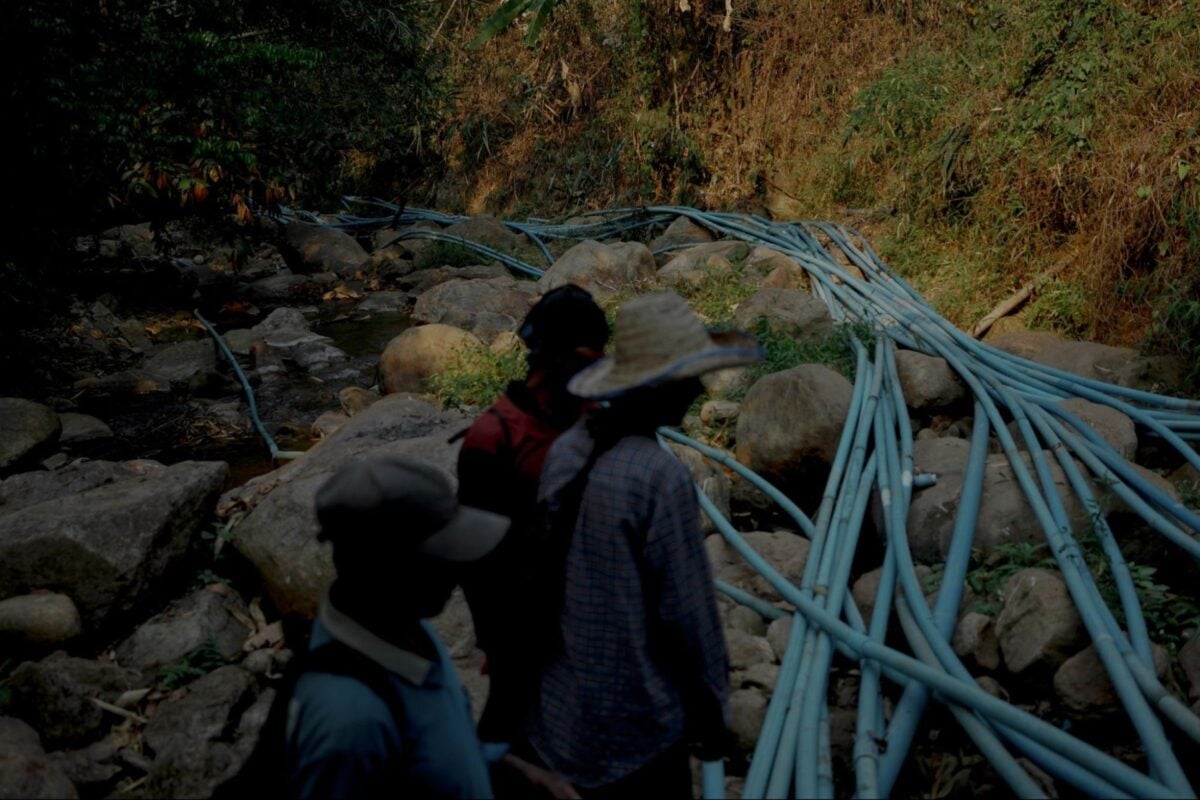CHIANG MAI, THAILAND ─ A relentless heatwave and a long drought influenced by El Niño weather patterns have escalated a water dispute in a community in Thailand’s north, with rice and tangerine farmers contesting dwindling local water supplies.
“Pai, look at the check dam now! Someone has removed the sandbags, and the water isn’t diverting into your field,” Somsak Kueankaew, a farmer, shouted to his friend.
Somsak and about 170 rice farmers in Chiang Mai’s northern Mae Sao sub-district have been forced to take turns guarding the Mae Hang and Mae Sao creeks, the major sources of water that supply nearly 2,310 hectares of rice fields and tangerine orchards in their community.

Their actions were prompted by the excessive use of water from the creeks as rice and tangerines are both thirsty crops requiring intensive irrigation, especially in the summer.
“We’ve experienced a scorching heatwave that caused a water shortage, leading to more water thieves,” said Somsak, who is also the secretary of a local farmer group formed to manage water usage in Mae Sao sub-district.
What they guard against is the removal of sandbags used to channel water from the creeks to their rice fields, with the water flowing on elsewhere. Sometimes they find rocks placed in the waterway to direct water to specific agricultural areas.
“Ghost pipes”, or unauthorized water pipes used to divert water, have also appeared along the upstream creeks, with no one claiming ownership. More than 17 ghost pipes were discovered this year – the highest number ever reported.


This increasing contest for water has broken an earlier deal reached between the rice and tangerine farmers, who agreed in 2005 on the size of the pipes used for water diversion and the amount of water sharing ─ with 70% of the water from Mae Hang Creek going to rice farms and 30% to tangerine orchards.
“In normal circumstances, the water available from the creeks was sufficient to supply all the farms in Mae Sao,” said Surachart Malasri from the Department of Irrigation.
“But the water sources have become insufficient during the dry season the water cannot be stored for later use. Many farmers rent land for cultivation, and they are not allowed by the landholders to dig ponds to store water. They must depend on water flowing from the creeks.”
A prolonged dispute
Thailand and the whole of Southeast Asia have experienced very high temperatures this summer ─ starting from March to May when the weather was hotter and drier than in other months.
Condition have been exacerbated by the El Nino phenomenon, which has caused a longer than usual dry period. Some scientific research also links the intense heatwaves and long drought to climate change.
This year, the Thai government expects the average rainfall across the country to be 24% lower than normal, an improvement from last year when the rainfall was 40% lower.
Thai climatologist Seree Supratid, the director of the Center for Climate Change and Disasters at Rangsit University, recently warned that Thailand could see temperatures hit 50 degrees Celsius in the next 60 years if the Paris Agreement is not achieved.
The number of days when the temperature surpasses 40 degrees Celsius is also expected to rise from nine to 75 each year.



In Mae Sao, the impact of climate-related extreme weather has translated into an intense water dispute between rice and tangerine farmers.
Thirty years ago, tangerine orchards started to spread in Mae Sao and replaced lychee orchards. Driven by the rising price of tangerines, newcomers flooded into the area to cultivate tangerine trees on a commercial scale.
Some orchards encroached on the Doi Pha Hom Pok National Park, a hilly, lush forest where the Mae Sao and Mae Hang creeks originate.
Local authorities soon discovered plastic pipes of various sizes installed upstream to extract water to feed the tangerine orchards. Illegal check dams were also found along the creeks, a practice involving placing sandbags or rocks to hold water that is diverted to farms.
This resulted in rice farmers protesting to the owners of the tangerine orchards, and climbing up the hill to destroy the pipes.
They also filed complaints against the tangerine farms with local authorities and the National Human Rights Commission in 2005 ─ leading to an agreement on water sharing between the two farming groups.
This map illustrates the cultivation areas of rice (dark green) and tangerines (orange) in Mae Sao sub-district, Chiang Mai province, Thailand. Some tangerine orchard areas overlap with Doi Pha Hom Pok National Park (light green). GRAPHIC: Visarut Sankham
Local authorities also launched lawsuits against 117 owners of tangerine orchards who installed pipes upstream in the creeks. The tangerine farmers, on the other hand, sued the rice farmers for damaging their pipes.
In 2021, the Administrative Court decided that the owners of tangerine orchards must dismantle the pipes. They appealed, and the court case continues.
A ‘temporary solution’
Although the dispute continues, the rice and tangerine farmers need to work with each other for their businesses to survive in the ongoing heatwave and drought, locals say.
They reached a new agreement in March, in which they would rotate the use of water in Mae Hang Creek – a deal seen as a “temporally solution”. The rice farmers can use all the diverted water from the creek for five days, while the tangerine farmers can use the water for three days.
The owners of some tangerine orchards also agreed to dig ponds inside their compounds to store water, so they have water when the rice farmers take turns to use the water from the creek.
However, the amount of water is still insufficient to support the growth of tangerine trees, said one owner of a tangerine orchard, who wish to stay anonymous.
“Whenever the water level in our pond lowers, the tangerine trees will respond quickly. Their leaves will dry out and curl.
I’ve seen many orchards being abandoned. Some orchard owners are unable to bear the maintenance costs and the increasingly hot weather, leading them to let the trees die.”

Growing tangerine trees requires water throughout the production season, which can last from seven to 10 months.
A farmer who owns a 32-hectare tangerine orchard in Mae Sao explained that a tangerine tree requires about 900 liters of water per day. She planted 600 trees per hectare, meaning 540,000 liters of water is needed. That means 17.3 million liters per day for the whole orchard, or the equivalent of seven Olympic-size swimming pools.
Off-season rice requires nine million liters per hectare per season that spans about 90 days, according to the Department of Agriculture. This means 100,000 liters are needed per day.
Although the Department of Irrigation has encouraged rice farmers to plant alternative crops to reduce water usage in the dry season, many rice farmers in Mae Sao continue off-season rice as it’s their main source of income.
“We must pay for our children’s education, household bills and debt. We can’t simply stop doing this,” said rice farmer Somsak.

In an effort to end the water war, the Mae Sao Sub-district Administrative Organization (SAO) has proposed the construction of the “Mae Sao Reservoir”, in the hope of providing sufficient water to every party.
However, the project’s site overlaps with valuable watershed areas in the forest which require a thorough feasibility study. The environmental impact assessment is still underway and expected to be completed in October.
“If the reservoir is completed, both rice and tangerine farmers will take part in setting up a committee to manage the water,” said Somchai Suwan, the chief executive of the Mae Sao SAO.
He estimates that it will take at least eight years to make the reservoir materialize. Until then, the farmers may need to endure more drought and disputes over water.
This story was produced with support from the Internews’ Earth Journalism Network and the Australian Water Partnership. It was first published in Thai in Prachatham.
Visarut Sankham is a visual storyteller and documentary photographer based in Chiang Mai, Thailand.





